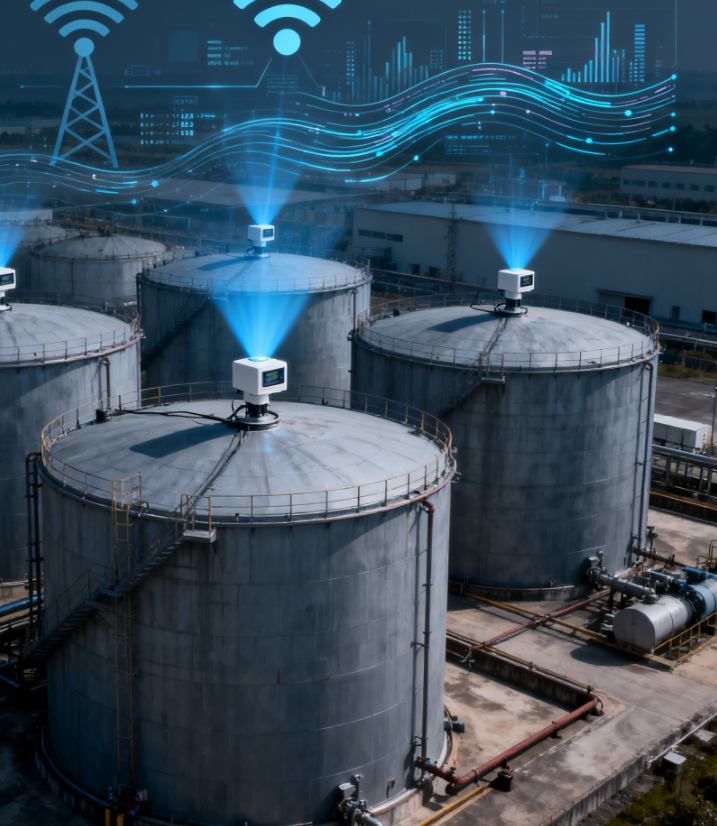Introduction
Accurate liquid level measurement is critical across industries such as chemical processing, water treatment, oil & gas, and smart infrastructure. Traditional methods—float sensors, ultrasonic devices, and pressure-based sensors—often face challenges: mechanical wear, environmental interference, and frequent maintenance.
With the rise of Industrial IoT (IIoT) and the demand for real-time monitoring, non-contact technologies like mmWave radar have become increasingly valuable. Unlike conventional sensors, mmWave radar provides high accuracy, reliability, and low maintenance, even in challenging conditions such as vapor, dust, foam, or extreme temperatures (TI E2E Forum, 2025).
At Linpowave, we integrate mmWave technology into solutions for industrial and consumer applications, enabling precise measurements and smart monitoring systems. Learn more about our mmWave sensor solutions for industrial automation.
Understanding mmWave Radar for Liquid Level Measurement
mmWave radar sensors operate by emitting electromagnetic waves (typically 24, 60, or 80 GHz) and measuring the time it takes for waves to reflect off liquid surfaces. This Frequency Modulated Continuous Wave (FMCW) method provides precise distance measurement, enabling accurate liquid level monitoring.
Advantages over traditional sensors include:
-
Non-contact measurement: Reduces contamination risk and eliminates mechanical wear.
-
High accuracy and wide measurement range: Industrial mmWave sensors can measure up to 40 meters with millimeter-level precision (DFRobot, 2025).
-
Environmental resilience: Resistant to temperature changes, humidity, foam, vapor, and dust.
-
IoT integration: Supports Modbus, MQTT, and other protocols for IIoT systems, enabling remote monitoring (Linpowave Industrial mmWave Solutions).
Industrial Applications
Chemical and Petrochemical Tanks
In chemical and petrochemical industries, precise tank monitoring is crucial for safety and operational efficiency. mmWave radar sensors operate reliably under high pressure, high temperatures, and corrosive environments. They provide consistent readings despite vapors or turbulence (Zero Instrument, 2023).
Water Treatment and Wastewater Management
Non-contact radar sensors are ideal for water treatment facilities. They monitor water levels in sedimentation tanks, reaction tanks, and storage reservoirs without contamination risk. Continuous monitoring helps optimize chemical dosing, prevent overflow, and comply with regulations.
Smart Cities and Environmental Monitoring
mmWave radar can monitor urban rainwater retention systems, sewage tanks, and reservoirs, offering real-time data for flood prevention and disaster management. This supports smart city infrastructure and public safety. For related applications, see our Smart Traffic and Urban Monitoring Solutions.
Technical Considerations
While mmWave radar offers substantial advantages, certain factors must be considered:
-
Environmental adaptation: Extreme conditions, such as high corrosivity or vibration, may affect sensor performance. Selecting proper sensor models and installation positions is crucial.
-
Installation and calibration: Multi-path reflections in irregular tanks can affect accuracy. Correct placement and periodic calibration ensure reliable readings.
-
Data integration: mmWave radar generates large volumes of data. Integrating it into IIoT platforms allows predictive maintenance, automated alerts, and operational optimization. See our Industrial mmWave Integration Guide for detailed best practices.
Future Trends
-
AI-enhanced smart sensors: Predict trends, detect anomalies, and automatically adjust calibration.
-
Multi-sensor fusion: Combine mmWave with pressure, flow, or temperature sensors for comprehensive process monitoring.
-
Edge computing and cloud integration: Process data locally for low-latency control, while cloud connectivity enables remote monitoring and analytics.
FAQ
Q1: Can mmWave radar measure foamy or turbulent liquids accurately?
Yes. Unlike ultrasonic sensors, mmWave radar is largely unaffected by foam or surface turbulence, providing reliable measurements in chemical reactors, fermentation tanks, and wastewater treatment systems.
Q2: How often should mmWave sensors be calibrated?
Calibration frequency depends on environment and application. Most industrial setups require annual calibration, though extreme environments may need more frequent checks (Zero Instrument, 2023).
Q3: Are mmWave radar sensors compatible with IIoT platforms?
Yes. Many sensors support protocols such as Modbus, MQTT, or OPC UA, enabling seamless integration into SCADA systems or cloud-based monitoring solutions.
Q4: What is the typical accuracy and range of mmWave radar level sensors?
Industrial mmWave radar sensors provide ±2–5 mm accuracy and can measure from a few centimeters up to 40 meters (DFRobot, 2025).
Q5: How do environmental factors affect performance?
mmWave radar is resilient to temperature, humidity, dust, and vapor. However, extremely high temperatures or aggressive chemical vapors may require protective housing or specialized materials.
Conclusion
mmWave radar represents a major advancement in liquid level measurement. Its non-contact design, high accuracy, and robustness make it suitable for a wide range of industrial applications. When integrated with IIoT systems, these sensors provide real-time insights, enabling predictive maintenance, operational efficiency, and enhanced safety.
Linpowave continues to innovate in mmWave sensing, offering solutions for industrial automation, smart cities, and advanced monitoring applications. Explore more on our product page or learn how mmWave can improve industrial monitoring.



